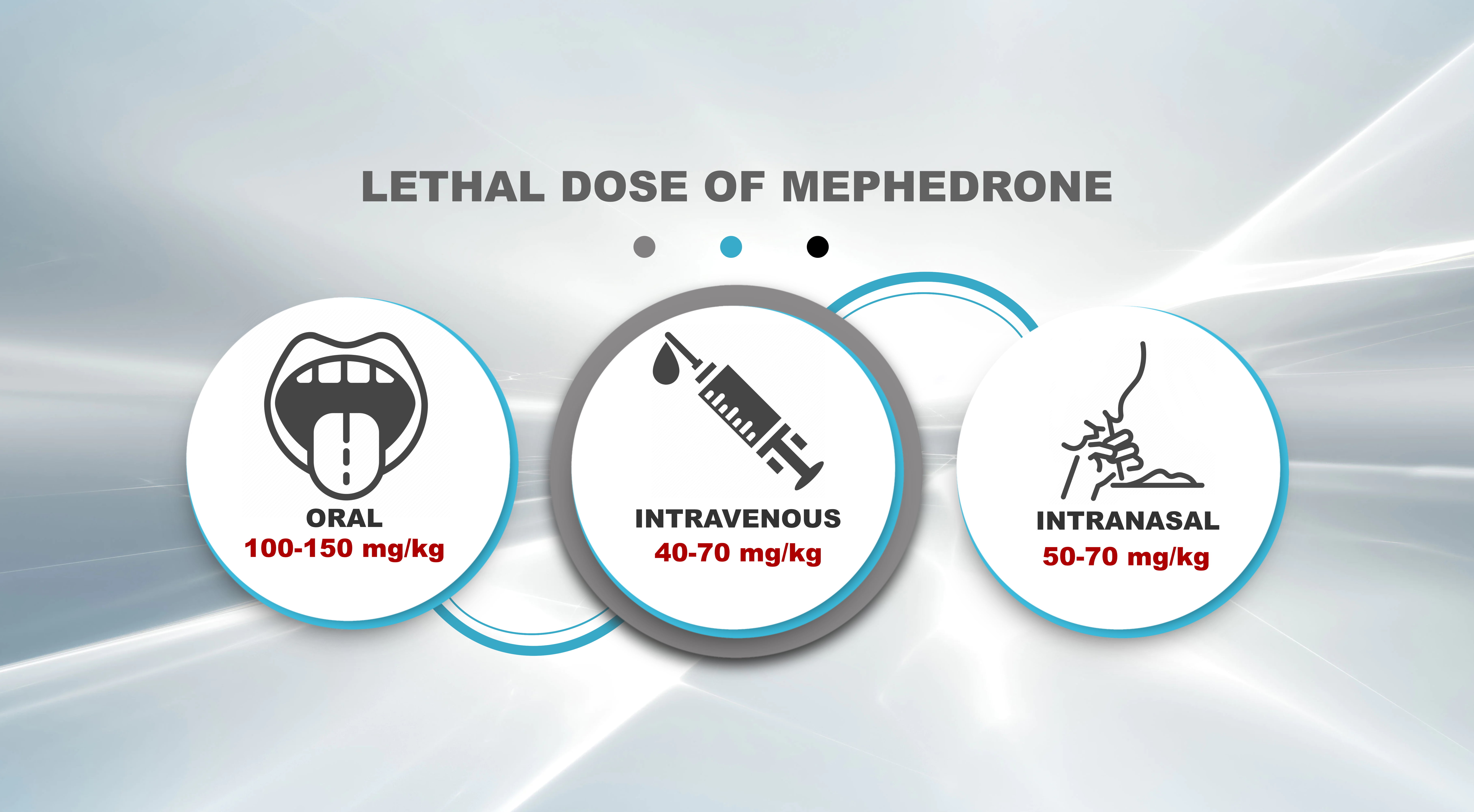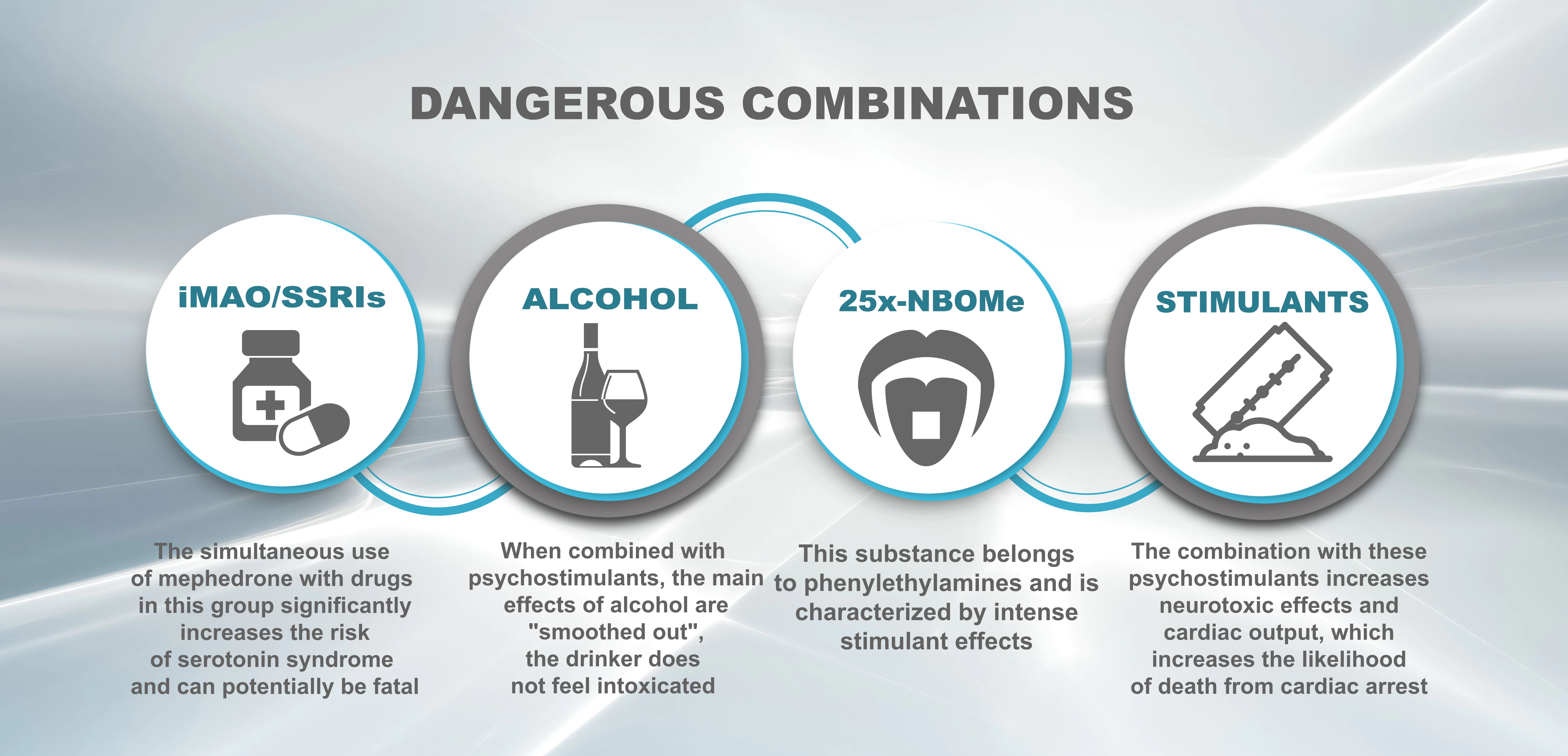The lethal dose of mephedrone has already been studied!
Mephedrone is a psychostimulant. Its action is based on increasing the concentration of catecholamines and monoamines in the nervous system. It increases the activity of the proteins that transport serotonin, dopamine and norepinephrine from the neurons into the synaptic clefts.
In addition, mephedrone inhibits the reuptake of these substances and reduces the activity of the enzymes that break them down. The amount of norepinephrine, which is responsible for mental and physical activity, increases dramatically. The content of serotonin and dopamine increases, providing euphoria, increased mood and a desire to communicate.
There are many ways to use mephedrone: orally, intranasally, intravenously, rectally. The probability of overdose and lethal outcome increases with intravenous injection of the drug solution, as in this case a large amount of the substance enters the bloodstream at one time.
The nervous system is intensively stimulated, including the structures responsible for heartbeat, vasoconstriction, breathing and other vital functions. When using mephedrone vision is temporarily reduced, heartbeat becomes faster, respiratory rate increases. The eyes under mephedrone turn red, the pupils dilate, the blood pressure rises, and the heart rate increases.
Lethality of mephedrone use
Fatalities directly related to mephedrone use have been repeatedly described in scientific literature and medical reports. For the first time, a fatal outcome as a result of taking the drug was officially registered in Sweden. A young man died as a result of cerebral edema and severe hyponatremia.
By 2012, 128 deaths directly related to mephedrone use had been described worldwide. Numerous studies have not been able to determine the minimum lethal dose of mephedrone. In 18 fatal cases, the presence of mephedrone in biological fluids was confirmed by laboratory data. In nine of the fatal cases, other psychoactive substances were detected in the biological media in addition to mephedrone.
A systematic search of published cases of fatal mephedrone intoxication in PubMed and Google Scholar databases yielded more than 400 fatal cases of mephedrone intoxication and about 300 non-fatal cases (2023 year). The typical participants were young men who had concurrently used mephedrone with other psychoactive substances (amphetamines, cannabis, alcohol, and antidepressants). The average blood concentration of mephedrone in fatal cases was about 2,700 ng/ml, and 200 ng/ml in non-fatal cases.
Causes of death when using mephedrone
Cardiovascular complications – mephedrone has been known to cause severe cardiovascular complications, including heart attacks, arrhythmias, and strokes. The drug’s stimulant properties can lead to increased heart rate and blood pressure, placing immense strain on the cardiovascular system. In some cases, this strain can result in myocardial infarction or ischemic stroke, ultimately proving fatal.
Serotonin syndrome – is a potentially life-threatening condition caused by excessive levels of serotonin in the body. Mephedrone, as a serotonin-norepinephrine-dopamine reuptake inhibitor (SNDRI), can lead to a dangerous accumulation of serotonin when used in conjunction with other serotonergic substances or medications. Symptoms of serotonin syndrome include agitation, confusion, rapid heart rate, and high blood pressure, which can escalate to seizures, coma, and death if left untreated.
Hyperthermia – mephedrone use can result in hyperthermia, a dangerous elevation of body temperature. This condition can cause organ failure, particularly in the liver and kidneys, as the body struggles to maintain its normal temperature. In severe cases, hyperthermia can lead to rhabdomyolysis, a breakdown of muscle tissue that releases a protein called myoglobin into the bloodstream, which can cause kidney failure and death.
Respiratory depression – although less common, mephedrone has been associated with respiratory depression, a potentially fatal condition characterized by slow, shallow, or irregular breathing. This can lead to a lack of oxygen in the body, causing brain damage, organ failure, and ultimately death.
Polydrug use and interactions – many mephedrone-related fatalities involve the concurrent use of other substances, such as alcohol, opioids, or benzodiazepines. These combinations can exacerbate the drug’s adverse effects, increasing the risk of overdose and death. For example, combining mephedrone with depressant substances like alcohol or opioids can lead to respiratory depression, while mixing it with other stimulants can heighten the risk of cardiovascular complications.
Accidental overdose – mephedrone’s potency and the variability in its purity can make it difficult for users to gauge an appropriate dose. This can result in accidental overdoses, with users ingesting a lethal amount of the drug.
Lethal dose of mephedrone
Mephedrone is a relatively new drug. Because of the statistically small number of deaths, the exact dosage of the substance that causes death has not been established. The standard amount taken orally is between 50 and 300 mg. When taken intranasally, 15-125 mg of mephedrone is enough to get high.
Most fatal cases are registered in people who injected the drug intravenously. When a large amount of stimulant enters the bloodstream at one time, the intensity of its effects increases dramatically.
The lethal dose of mephedrone ranges from 120-150 mg/kg for oral use, and the lethal dose for intravenous use is 50-70 mg/kg.
It is important to note that these rates of fatal mephedrone doses are based on experimental studies that were conducted on rats. And the results were extrapolated to the human body.
In addition, in real practice, fatal mephedrone intoxication can occur even when using smaller doses, this is due to a large number of factors, among them: the presence of chronic diseases, the combination of substances, physical activity, poor “quality” powder and so on. It is quite possible that fatal mephedrone intoxication can occur even when using standard doses of 50-100 mg.
Dangerous combinations
Mephedrone is not the most life-threatening psychostimulant. But its use in combination with other drugs and alcohol increases the risk of death and severe disabling complications.
The most dangerous combinations with mephedrone:
-
25x-NBOMe – this substance belongs to phenylethylamines and is characterized by intense stimulant effects. When mixed with mephedrone it may cause seizures, increased blood pressure, tachycardia and heart failure.
-
Alcohol – ethyl alcohol is a depressant (relaxing, drowsy). When combined with psychostimulants, the main effects of alcohol are “smoothed out”, the drinker does not feel intoxicated. But the effect of the drug stops earlier, and the alcohol continues to depress the nervous system. Therefore, for example, mephedrone with beer can cause respiratory arrest.
-
DXM – is a dissociative drug that disrupts perception of the environment and alters the functioning of consciousness. When combined with mephedrone, it causes panic attacks, suicidal thoughts, increased heart rate, and myocardial infarction.
-
MDMA/cocaine – the combination with these psychostimulants increases neurotoxic effects and cardiac output, which increases the likelihood of death from cardiac arrest. In addition, serotonin and dopamine levels increase dramatically and serotonin syndrome develops.
-
iMAO and SSRIs – the simultaneous use of mephedrone with drugs in this group significantly increases the risk of serotonin syndrome, which is a dangerous complication of this combination and can potentially be fatal.
Conclusion
In conclusion, the exploration of lethal doses of mephedrone serves as a stark reminder of the delicate balance between pleasure and peril that accompanies the use of psychoactive substances. As we have delved into the intricacies of mephedrone’s lethal dosage, dangerous combinations, and the significance of adhering to minimum doses, we have illuminated the precarious nature of this substance and the responsibility that falls upon users and society alike.
The journey through this article has underscored the importance of understanding the limits of mephedrone consumption, as well as the potentially fatal consequences that may arise when these boundaries are transgressed. By shedding light on the lethal combinations of mephedrone with other substances, we have emphasized the need for vigilance and caution in the pursuit of recreational experiences.
Furthermore, our discussion on the necessity of adhering to minimum doses of mephedrone has highlighted the role of harm reduction in safeguarding the well-being of users. It is through the dissemination of accurate information and the fostering of a culture of awareness that we can hope to mitigate the risks associated with mephedrone use.
In the realm of psychoactive substances, knowledge is power, and with this power comes the ability to make informed choices that prioritize safety and well-being. May this article serve as a beacon of enlightenment, guiding readers towards a deeper understanding of the risks associated with mephedrone use and inspiring a commitment to responsible, conscientious consumption.



